Edible forest or forest garden
The forest garden has been practiced for millennia in many tropical regions, but it is also possible in more temperate climates...
Edible forests have also figured prominently in the concerns of permaculture, a different approach to modern agricultural systems, which mimic natural ecosystems.

Come and take part in our workshops on the edible forest or forest garden which takes place Monday to Friday from 7 a.m. to noon.
Edible forests have always occupied a very important place in the concerns of permaculture, a different approach to modern agricultural systems, which imitate natural ecosystems.
The workshops are:
- planting fruit trees
- pruning fruit trees
- layering and grafting
- maintenance of the edible forest in the rainy season from June to October.
Saturday and Sunday off
INTERESTED IN THIS EXPERIENCE? CHECK OUT OUR WOOFING IN THAILAND PAGE
The edible forest in a nutshell
🌳 PERMACULTURE aims, in its application to the garden and vegetable patch, to imitate nature in order to obtain more abundant harvests. In concrete terms, this means putting in place systems that have the same characteristics in terms of diversity and resilience as the natural ecosystems that have existed for millennia.
🌳 AGROFORESTRY refers to all practices combining trees, crops and sometimes animals, on the same plot of land, seeking complementarity between the different living elements. For example, trees bring up water and minerals from deep soils, which will benefit surface crops. In addition, 40% of tree biomass returns to the soil each year, resulting in continual enrichment of the soil.
🌳 In this dynamic, the garden-forest is therefore an edible garden, which imitates the structure and diversity of a real natural forest. It has different levels of vegetation (STRATES). Food trees, fruit trees, shrubs, herbaceous perennials, aromatics, root vegetables, edible lianas or even mushrooms are skilfully associated with it. Sometimes there is a body of water which further enriches the complexity of the system. For our part, we have also installed a vegetable garden and beehives there, hoping to have better pollination…
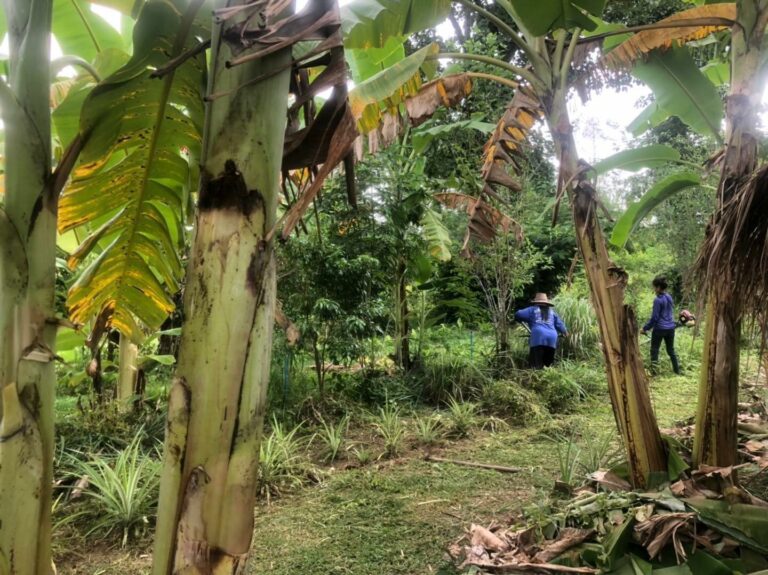
Usefulness of the edible forest, of the forest garden
We could define the forest garden as a perfect, easy and complete organic garden. Does a forest need ploughing, weeding, fertilizer or irrigation? No, indeed… And that is the goal of the process!
In fact, since these are mainly perennial crops, plowing is not mandatory. Not tilling preserves the natural structure of the soils, preventing the loss of topsoil and allowing all the little microbes and creatures of the earth to do their job, recycle nutrients and maintain the fertility of the environment. The deep roots of trees and shrubs make them much more drought tolerant than annual vegetables, and they provide shade for the smaller plants below, keeping everything lush and moist in a self-sustaining system, besides. in other words, a perfectly sustainable system…

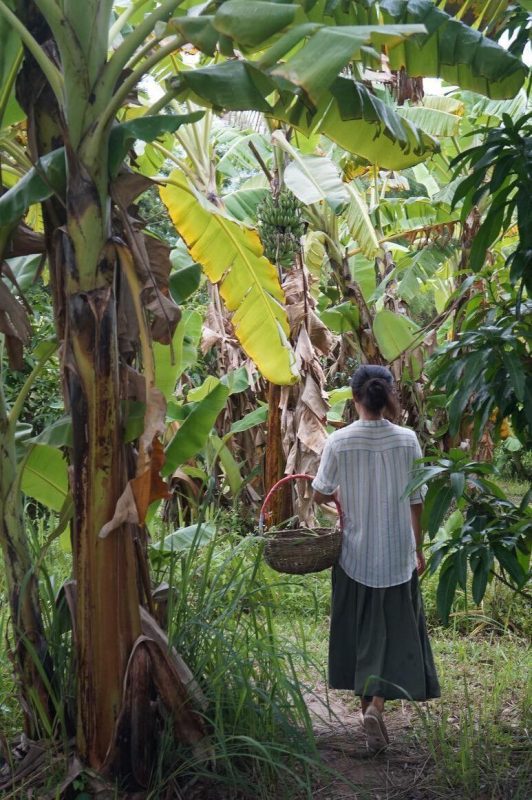
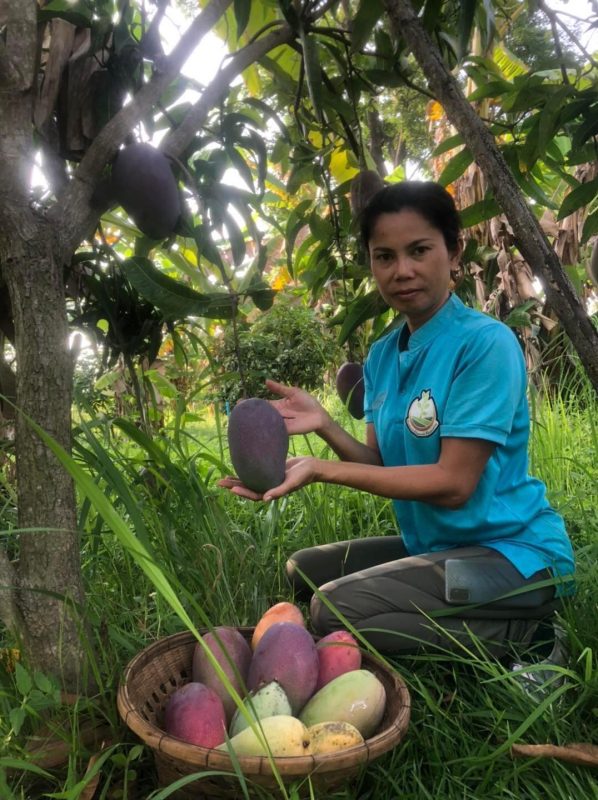
I must tell you that we started construction in 2019 and that we will have to be patient until 2030 to fully reap the benefits and for the edible forest to be perfectly autonomous…
How to start a forest garden, an edible forest?
The first step in building a food forest is choosing your plants. The tallest plants will reach the sun, so fruit trees and shrubs are the most common. Smaller plants generally need to be more shade tolerant as they will be in the understory. But you can leave sunny patches here and there, like small forest glades, to accommodate species that need more light (see Step 3 for a tip for making the most of available sunlight).
The essential elements
- THE CANOPY: This layer is primarily for large nut trees that require full sun throughout the day, such as pecans, walnuts and chestnuts, we also use teak
- UNDER OLD TREES: This layer is for small nut trees, such as filberts, and most fruit trees. The most shade-tolerant fruit trees include species like black mulberry, papaya, mango, vines: grapes, kiwi fruit and passion fruit are the best-known edible vines, although there are many others more obscure specimens to consider, some of which are fairly shade-tolerant, such as ), chayote (a perennial squash), and groundnut (a perennial root).
- HERBACEOUS PLANTS: This category not only includes plants commonly considered herbs – rosemary, thyme, oregano, lavender, mint and sage are some of the best perennial culinary herbs to consider for your forest garden. – but it’s a catch-all term for all leafy plants that lie dormant underground in winter and sprout from their roots in spring. This layer is where perennial vegetables are integrated, such as artichokes, rhubarb, asparagus and Thai squash and eggplant…
- GROUND COVER: These are perennial plants that spread out horizontally to colonize the ground plane. Edible examples include strawberries, sorrel, nasturtiums here, watermelon and melon as well.
- THE RHIZOSPERE: This refers to root crops. It’s a little misleading to call it a separate layer, since the top of a root crop can be a vine, shrub, ground cover, or grass, but it’s a way of reminding us to consider this as part of overall food production.
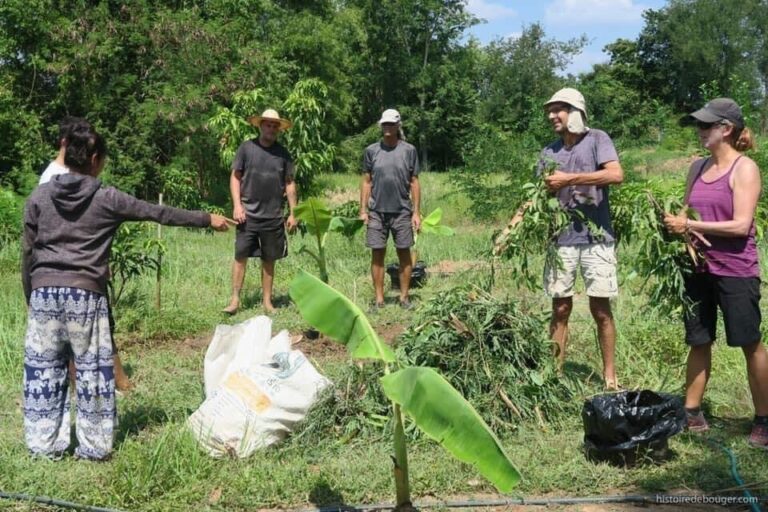
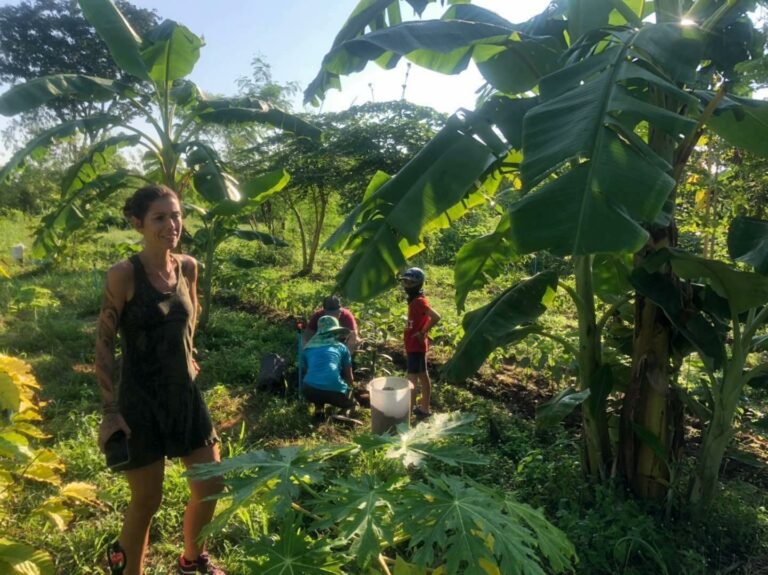
What you need to know to make it work
The choice of species that will be planted in a garden-forest requires reflection and the knowledge of the guilds. It is, in permaculture, associations of plants that cooperate with each other, in order to better develop. Some plants attract pollinators, others fix nitrogen or repel insect pests. Their different vegetative forms allow them not to compete with each other. Guilds are a combination of forms and functions, based on natural cohabitations.
By observing nature, we find natural associations of wild plants that have chosen to grow together. In permaculture, we will then seek to recreate these natural guilds. The study and identification of these guilds is called phytosociology.
In edible forests, for diversified, abundant and sustainable gardens, we have every interest in drawing inspiration from nature. Far from traditional agriculture advocating monoculture, the natural model teaches us the benefits of a diversified, multi-layered, dense culture, composed of plants that support and help each other.
The guilds are the key to the design of the forest garden and what constitutes its main assets: resilience, abundance and biodiversity…
For a guild to work, assume that you must group together plants that fulfill at least three different functions among the following:
Nitrogen fixers
Plants bringing back mineral elements
Structural plants for the soil, loosening it with their roots
Structuring plants for the aerial parts (providing shade, protecting from the wind, serving as a stake, etc.)
Attractive plants (pollinating or attracting predators, thereby protecting their neighbors)
Repellent plants for undesirables.


The final word...
Agroforestry can have immense benefits for the environment and the farmer. For farmers, the ability to maintain some sort of control over land and production in the face of climate change means that agroforestry could hold great promise for the agricultural sector.
Environmentally, the ability of agroforestry to help prevent soil erosion while simultaneously promoting water retention and boosting soil fertility could help provide a solution for areas where Rains are erratic or could become erratic due to climate change while dense plantings of trees would also help absorb CO2 and regulate local temperature.
In a nutshell, the objectives of a garden-forest therefore consist in the creation of a sustainable, diversified and dense ecosystem, resilient enough to face disturbances such as global warming, and which will offer you abundant harvests.